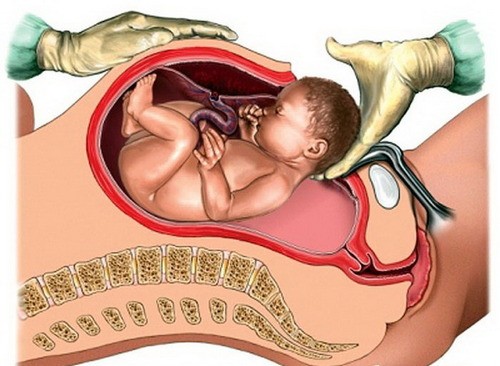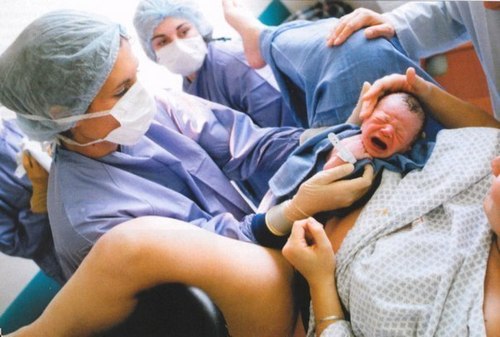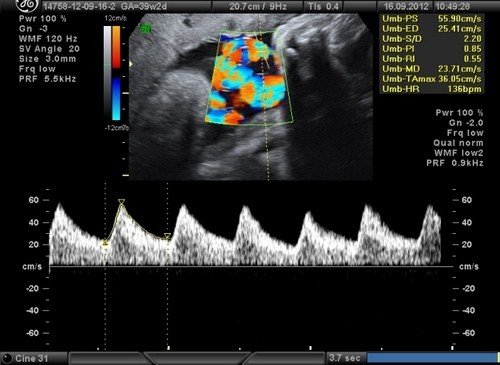The fetus at 42 weeks of gestation is already fully formed. However, its “overriding” is highly undesirable. However, according to statistics, 95% of babies born at this period do not have any deviations associated with portability.
The weight of the child at 42 weeks of gestation is from 3.5 to 4 kg, the growth of the baby reaches, on average, 54 centimeters. A small heart beats at a frequency of 120-160 beats per minute.
The children’s body is already ready for independent work, the baby is only waiting for the moment of birth.
What’s new in baby development
The development of the fetus at 42 weeks of gestation is as follows:
- The unborn child continues to actively “take” calcium from you. The bones of the skull are actively strengthened, with the exception of two small areas – fontanelles;
- The baby is actively gaining weight. Try to reduce the calorie content of your diet, as a large fetus may experience minor complications when passing through the birth canal;
- The hair on the head has already grown well, now the baby has a magnificent hairstyle;
- The nails on the hands and feet may protrude beyond the tips of the fingers. So immediately after birth they can already be cut;
- Now the baby’s body is preparing for a very important event in its life. Adrenal glands work in a mode of increased activity. They produce a hormone that helps a small person cope with the stress of birth.

Signs of fetal overriding during prolonged pregnancy
Normally, the duration of pregnancy may well be 42 weeks. However, at this time the child may already show signs of overriding.
These include:
- Dry skin;
- Wrinkling and peeling of the skin;
- Lack of generic lubricant;
- Excessive length of nails and hair;
- Increased activity caused by oxygen starvation.
Pregnancy, which lasts longer than 42 weeks, is called postponed.
However, overriding and over-tolerance are different concepts. Childbirth can be late, but the fetus will not be overripe, and may be premature, but with obvious signs of overriding. To avoid the risk of complications, doctors, as a rule, try to cause childbirth after the 40th week of pregnancy.
Well-being and condition of the future mother
The forty-second week of pregnancy will not bring many new symptoms. It practically does not differ from any of the weeks of the third trimester.
Symptoms at 42 weeks of gestation
- Most likely, you are concerned about problems with the intestines. Unfortunately, they will accompany you until the birth itself;
- The extension of the pelvic bones continues, the cervix by this time is usually already softened and shortened;
- The baby falls lower and has a significant effect on the blood supply to the pelvis, as a result, severe swelling of the legs may appear. Especially it becomes noticeable by the end of the day;
- The hemorrhoids already making itself felt worsen;
- Perhaps varicose veins in the legs;
- Pain appears in the joints, lower abdomen, as well as in the lower back and in the sacral region.
Psychological and emotional state
Every expectant mother is looking forward to the moment of meeting with the baby. Especially the feeling of excitement grows towards the end of pregnancy.
Every day the tension increases, and not only from the physical, but also from the psychological point of view:
- the feeling of irritability intensifies;
- more difficult to overcome fatigue;
- there is a constant concentration on only one desire – to give birth as soon as possible.
Fatigue is supplemented by physical exhaustion. During this period, a pregnant woman especially needs the support of her relatives.
Discharge shortly before delivery
In the very last days of pregnancy, the abundance of secretions increases. Their consistency becomes more mucous due to the detachment of the cork, which closed the entrance to the uterus.
Normally, the allocation should be:
- homogeneous;
- bright;
- with a slightly sour mild odor.
Allocations have become inflammatory if:
- blood impurities appeared;
- the consistency has become curdled or frothy;
- an unpleasant odor has occurred.
What does the stomach look like and its size
Consider what happens at 42 weeks of gestation with your stomach. Most likely, at this time, finally, there is relief. It is due to the fact that the stomach fell lower, freeing up more space for your internal organs. It becomes not only easier to breathe, but also the digestive organs begin to better perform their functions.
The size of the fetus reaches its maximum at 42 weeks of pregnancy, so the skin on the abdomen is extremely stretched. It is very itchy and itchy, stretch marks at this period are not uncommon if you did not use any means to prevent their occurrence during pregnancy.
It must be understood that 42 weeks of pregnancy is the deadline when a decision is made on the method of delivery. If delivery does not begin in the next few days, additional stimulation will be required, or delivery will occur by cesarean section.

Medical examinations for 42 weeks
Going to an appointment for a antenatal clinic, you, as before, will need to first pass the urine for analysis. There are also a number of studies that are prescribed according to indications for a period of 42 weeks.
Ultrasound investigation and its results
Ultrasound at the forty-second week of pregnancy is aimed mainly at assessing the following parameters:
- Sizes of the baby. The size of the fetus at the forty-second week of pregnancy is the same as it will be after its birth. The study of this parameter is especially important at this time, since it is necessary to correlate the size of the fetus with the width of your pelvis. This allows the doctor to determine the method of delivery;
- The condition of the placenta and the quality of its work. The closer the PDR, the worse the placenta performs its nutritional and oxygen-conducting functions. Usually at this period, the degree of placental aging is III;
- Amount and structure of amniotic fluid. The doctor will evaluate the structure of amniotic fluid for the presence of suspensions in it. At this time, meconium (original feces) already enters the amniotic fluid, as a result of which they become cloudy;
- The degree of maturation of the cervix. There is a certain classification that allows you to divide the cervix by maturity into three groups: immature, not mature enough, mature. By the time labor begins, the cervix should soften and contract, the pharynx should open 10 cm.
Other indicative procedures
Dopplerography is a study that is performed using Doppler. It allows you to determine whether the child is adequately provided with oxygen and nutrients.
Cardiotocography reveals the relationship between the baby’s heartbeat and uterine contractions. Thanks to this study, the doctor is able to detect the presence of hypoxia in the fetus.
Amnioscopy is a procedure that is performed to determine the quality of amniotic fluid. In parallel, a urine test is given, according to the results of which you can evaluate the functionality of the kidneys.
Why I do not give birth and stimulation of labor
Delivery at 42 weeks of gestation is the most anticipated event. If there are still no signs of the onset of natural birth, the doctor will strongly recommend that you stimulate labor.

Childbirth and Caesarean section
Medical stimulation of childbirth
During the stimulation procedure, the doctor uses the drug oxytocin – a hormone that causes the uterus to contract. Prostaglandin is also widely used, which helps the cervix soften.
If after all these manipulations the pharynx does not open, you have to pierce the amniotic fluid (do not be afraid, it does not hurt!).
Caesarean section is usually prescribed only in emergency cases, if:
- there is a threat to the life and health of the child and mother;
- premature placental abruption occurred;
- revealed fetal hypoxia;
- the diameter of the child’s head does not allow him to pass through the birth canal (according to ultrasound).
Folk methods of stimulating labor
The ideal way to help yourself with the issue of starting the birth process at 42 weeks of pregnancy is sex. Male semen contains biologically active substances prostaglandins, which are an excellent tool for softening the cervix.
In addition, sexual arousal leads to improved blood circulation, which can also provoke contractions.
You can do a nipple massage. The female body responds to such manipulations by releasing the same hormone oxytocin, which doctors use to induce the onset of labor.
Physical activity can accelerate the onset of labor:
- mopping;
- climbing stairs;
- charging.
Some especially brave women resort to funds that lead to rapid intestinal work, because this can also provoke a uterine contraction. For this purpose castor oil is used, enemas are made, belladonna candles are inserted.
Please note that all these methods can be used only after consultation with an obstetrician-gynecologist.
How is the birth process
Regardless of whether your birth is planned or emergency, they occur the same way and are divided into three stages:
Cramping or cervical dilatation. Contractions are painful periodic contractions of the uterus. Unlike training fights, the interval between the present is much smaller. If you suspect that you have started contractions, record the time between them. These contractions have a clear schedule, indicating the beginning of the birth process. You can go to the hospital when the interval between them is 5-7 minutes. But it’s better not to delay, because there are cases of rapid childbirth, when only 2-3 hours pass between the first contractions and the birth of a child.
Help the baby leave the womb – attempts. At this stage, it is very important to concentrate on breathing. Pushing right is not an easy task. Both the duration of the birth and the consequences (tears and cracks) depend on how well you follow the instructions of the midwife.
Birth of an afterbirth. After the birth of the child, the placenta is born, usually this procedure is painless for a woman. Childbirth at the forty-second obstetric week of pregnancy needs careful monitoring by obstetricians, since they are often accompanied by some complications.
These include:
- anomalies of labor;
- incorrect insertion of the head;
- the development of hypoxia.

In this regard, delivery by the emergency cesarean section method at such times is more common than usual. For the fetus, childbirth at this period is characterized by an increased level of injuries. This is due to the fact that the bones of the skull are already gradually becoming not as plastic as several weeks earlier.
Recommendations and advice for the expectant mother
In the last days of your pregnant state, it is important to carefully monitor all changes occurring in your body.
Expectant mother is recommended to adhere to the following principles:
- Eat right. This will help you get rid of digestive problems such as bacteriosis, constipation and diarrhea. You need to eat often, but in small portions;
- Give preference to products that are rich in plant fibers (vegetables, fruits, baked goods from wholemeal);
- Do not forget about foods rich in calcium and prebiotics. Eat milk, kefir, fermented baked milk, yogurt;
- When leaving home, take with you documents, an exchange card and a mobile phone so that the birth that you begin does not take you by surprise;
- Put the “alarm case” with things for the hospital near the entrance in a prominent place so that your relatives can easily find it if necessary.
Remember, you are at the finish line! Very soon, the long-awaited child will sniff at your side! The joyful day is not far off when you hear your baby’s first cry! Everything will be fine, the main thing is the right attitude to a positive result.
This material is for informational purposes only, before using the information provided it is necessary to consult with a specialist



